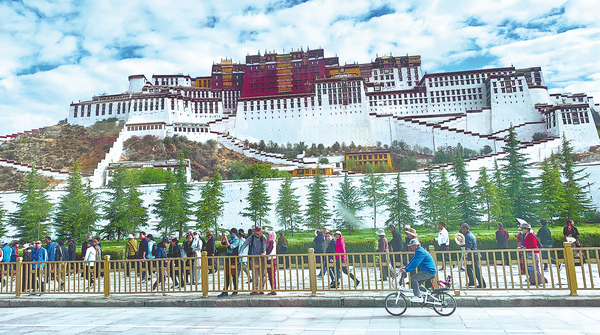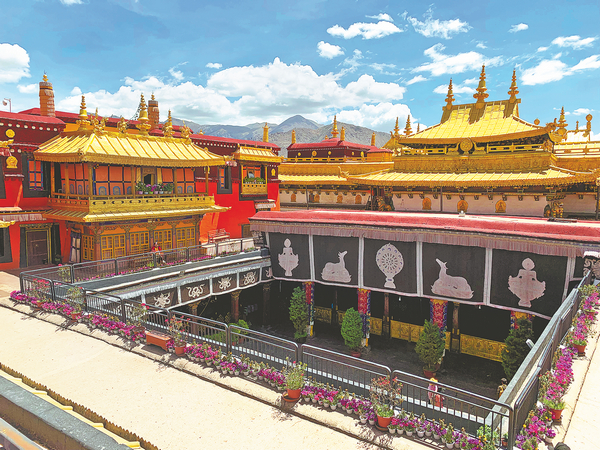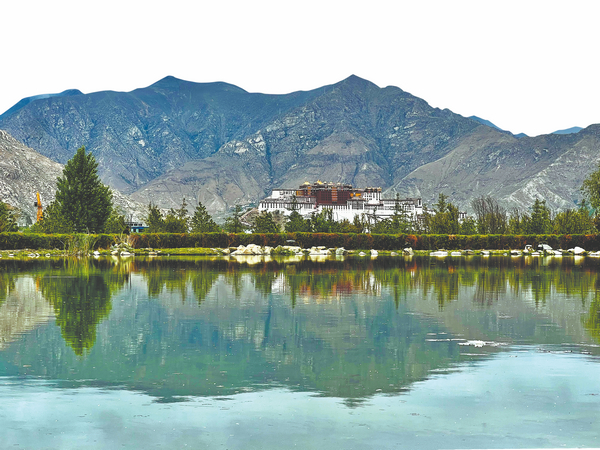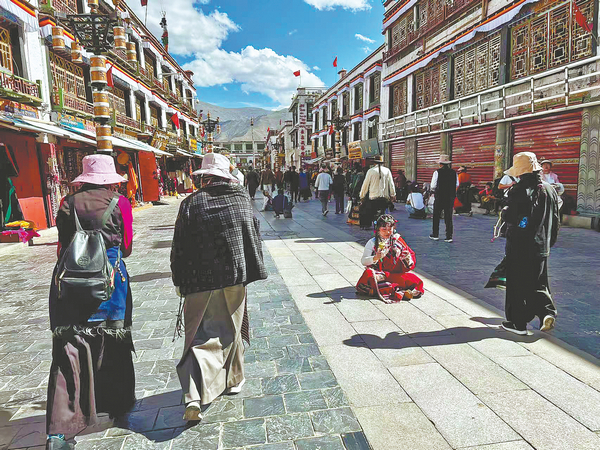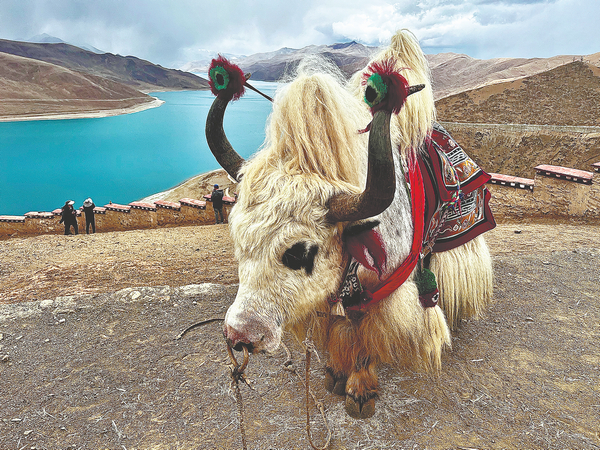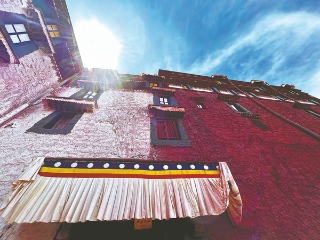Potala Palace
The Potala Palace doesn't just dominate Lhasa's skyline — it defines it. Jutting 116 meters from the crest of the Red Mountains, its red-and-white tiers gleam like a mythical bastion come true.
For centuries, pilgrims have braved thousands of kilometers to reach this spiritual beacon. They drop to their knees every few steps and slide forward on wooden boards lashed to their elbows and knees that clack as they bow to the ground.
Inside, thousands of rooms accommodate over 100,000 artifacts. The air billows with smoke from joss sticks so condensed that's not just visible, but tangible. You not only see it but feel it tickle your eyes, as it carries the prayers of countless believers skyward.
Norbu Lingka
Norbu Lingka lives up to its Tibetan name of the "Treasure Garden".
This lush 374-room compound was built as the seventh Dalai Lama's summer palace in the mid-1700s and has since blossomed into Xizang's largest man-made garden. Over 100 plant varieties, including rare Himalayan species, flourish throughout the sacred sanctuary.
Dancers in yak costumes stage operas, and visitors are invited to join twirling circle dances.
Undeniably, Lhasa's ancient "treasure garden" still sparkles with life.
Jokhang Temple
An old Tibetan saying goes: "First, Jokhang was built. Then, Lhasa came to be." The pulsing "heart of Lhasa" still powers the city's spiritual circulatory system.
It exerts a gravitational pull that tugs pilgrims into its orbit, as they ceremoniously circumambulate its sacred nucleus. They circle around the compound along a 1,300-year-old, 1-kilometer walkway that teems with pilgrims whirling prayer wheels and bowing to the ground.
Legend has it that King Songtsen Gampo flung his ring, vowing to build a temple wherever it landed. It plopped into a lake, from which a white stupa rose like a lotus. The lake was filled in, and Jokhang was built on its bed.
Inside rests the venerated sleeping Buddha statue — portraying a 12-year-old Sakyamuni — that Tang Princess Wencheng brought to the city when she married Tubo King Songtsen Gampo. Jokhang still hosts the ceremony for drawing lots from a golden urn to confirm living Buddhas, immortalizing this tradition and the temple's eminence.
Nanshan Park
Nanshan's prominences become the city's easels at dawn and dusk, luring dozens of painters and photographers. The Potala Palace glows on the watercolor horizon and its dreamlike reflection shivers across the Lhasa River's ripples.
These once-barren, sallow slopes have taken on new life as a verdant woodland where cedar, pine and spruce jostle for sunshine, thanks to a 500 million yuan ($69.4 million) reforestation project. Now, the leaves of over one million trees applaud the breezes as they flutter like the prayer flags that dangle above traditional tents and mani stones inscribed with scriptures.
Princess Wencheng
History dances to life every evening in a vast amphitheater, where 800 performers put on the musical drama, Princess Wencheng, that tells the story of her journey to Tubo to wed King Songtsen Gampo. The production is epic, not only in terms of story but also in scale. It fuses ancient folklore with cutting-edge stagecraft, and unfolds in front of massive replicas of Jokhang and Potala.
It unfolds in five acts that embed the plot within traditional culture: Charm of Ancient Tang Dynasty, Buddhist Music of Heaven and Earth, Great Beauty of Tibetan Dance, God of the Plateau and Harmonious Beauty Between Tibetan and Han.
This epic echoes through the ages, resonating until today.
Barkhor Street
Barkhor and its tangled side streets coil like a spiritual circuit around an eponymous square. For over 1,300 years, pilgrims have spun prayer wheels and ceremoniously marched around its circumference.
Its traditional architecture hosts a kaleidoscope of 20 ethnic groups, including Tibetan, Han, Mongolian and Hui. Its shops are packed with virtually every kind of folk art crafted in Xizang, including thangka paintings, yak-butter lamps and traditional incense handcrafted from dozens of ingredients that grow wild on the plateau.
Barkhor is a living labyrinth, where you can lose yourself in what makes Xizang Xizang.
Xizang Museum
The Xizang Museum displays a variety of Buddha and Bodhisattva statues wrought from virtually every medium. It exhibits ancient Tibetan books inscribed with gold, silver and coral. And it showcases technicolor thangka paintings, as well as a mosaic of other ethnic items.
The institution houses the permanent exhibitions, Tibetan History and Culture and The People Closest to the Sun — Tibetan Folk Culture, in addition to temporary displays. It enables visitors to explore the vastness of Xizang before venturing beyond the museum's walls.
Sera Monastery
The monks who clap fiercely in the courtyard of Sera Monastery aren't applauding. They're arguing.
The act of brashly slapping one's right hand on an extended left hand is part of a Buddhist debate format adopted in the 11th century. Monks thwack their palms to challenge an argument, emphasize a question or declare the beginning of a proposition.
The dramatic gesture and loud sound are meant to snap participants out of any distraction, literally smacking their attention into focus. They are accompanied by other dramatic poses that represent different meanings.
Sera is hailed as one of Lhasa's three great Gelug university monasteries, and the dramatic debates are part of its scholarly legacy.
Its name translates as "wild roses", purportedly because these flowers bloomed on Mount Pubuchok when the monastery was built at its foot in 1419.
The 11-hectare compound also hosts the Main Assembly Hall, the Three Sand Mandala Chapels and the Hayagriva Chapel hidden in a secret cave that houses a horse-head deity.
But the main draw for outsiders remains the animated debates that are staged like melodramatic performances.
Yamdrok Yutso Lake
A couple of hours' drive from Lhasa, Lhokha prefecture's Yamdrok Yutso Lake is not only the sparkling jewel of the area's scenery but also its "jewelry". Locals refer to it as "the turquoise earrings scattered by a goddess". They also call it the "jasper lake above the prairies", "swan lake", and "the most beautiful lake in the world".
No terrestrial viewpoint permits you to see it in its entirety, a glittering expanse of nearly 340 square kilometers at over 4,400 meters.
Visitors to the body of water, which is one of Xizang's three holy lakes, can also discover nearby glaciers, hot springs, islands, temples, grasslands and mountains that stab over 7,000 meters skyward.
Yamdrok Yutso is geographically close but geologically distant from Lhasa.
Lhasa similarly stands between worlds — a human realm grounded in the corporeal and an Elysian domain, elevated by belief in the beyond.
It's a liminal destination where heaven and Earth convene, and the divine appears so close that you can reach out and touch it. Many try. Some do.


